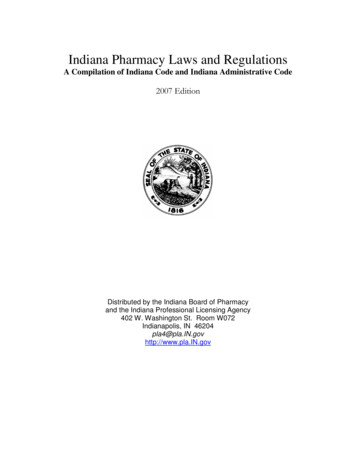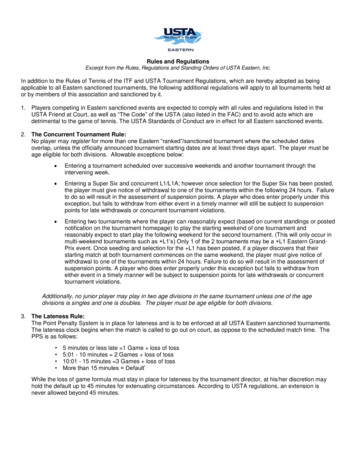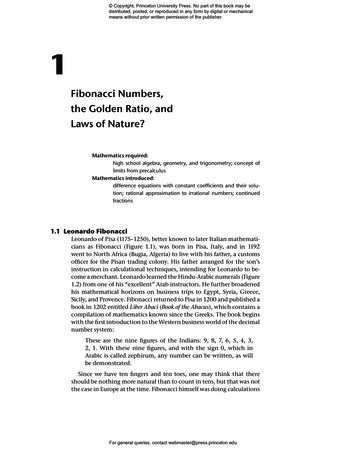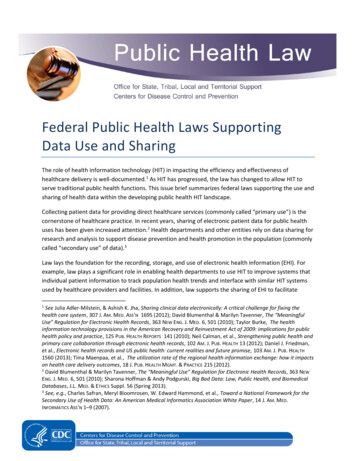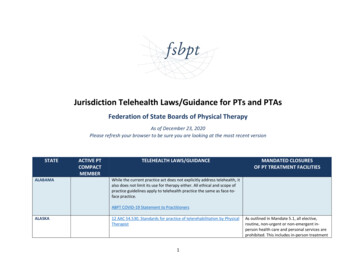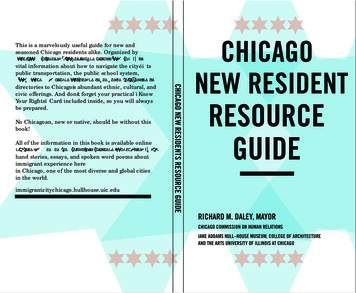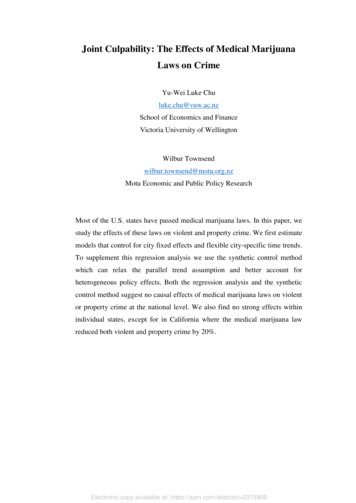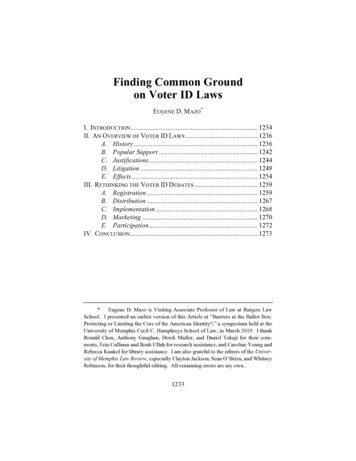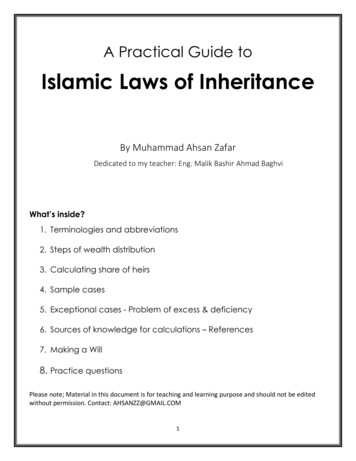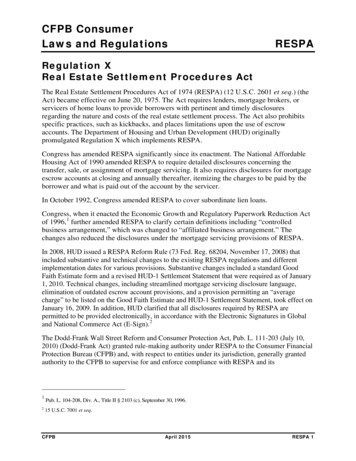
Transcription
CFPB ConsumerLaws and RegulationsRESPARegulation XReal Estate Settlement Procedures ActThe Real Estate Settlement Procedures Act of 1974 (RESPA) (12 U.S.C. 2601 et seq.) (theAct) became effective on June 20, 1975. The Act requires lenders, mortgage brokers, orservicers of home loans to provide borrowers with pertinent and timely disclosuresregarding the nature and costs of the real estate settlement process. The Act also prohibitsspecific practices, such as kickbacks, and places limitations upon the use of escrowaccounts. The Department of Housing and Urban Development (HUD) originallypromulgated Regulation X which implements RESPA.Congress has amended RESPA significantly since its enactment. The National AffordableHousing Act of 1990 amended RESPA to require detailed disclosures concerning thetransfer, sale, or assignment of mortgage servicing. It also requires disclosures for mortgageescrow accounts at closing and annually thereafter, itemizing the charges to be paid by theborrower and what is paid out of the account by the servicer.In October 1992, Congress amended RESPA to cover subordinate lien loans.Congress, when it enacted the Economic Growth and Regulatory Paperwork Reduction Actof 1996, 1 further amended RESPA to clarify certain definitions including “controlledbusiness arrangement,” which was changed to “affiliated business arrangement.” Thechanges also reduced the disclosures under the mortgage servicing provisions of RESPA.In 2008, HUD issued a RESPA Reform Rule (73 Fed. Reg. 68204, November 17, 2008) thatincluded substantive and technical changes to the existing RESPA regulations and differentimplementation dates for various provisions. Substantive changes included a standard GoodFaith Estimate form and a revised HUD-1 Settlement Statement that were required as of January1, 2010. Technical changes, including streamlined mortgage servicing disclosure language,elimination of outdated escrow account provisions, and a provision permitting an “averagecharge” to be listed on the Good Faith Estimate and HUD-1 Settlement Statement, took effect onJanuary 16, 2009. In addition, HUD clarified that all disclosures required by RESPA arepermitted to be provided electronically, in accordance with the Electronic Signatures in Globaland National Commerce Act (E-Sign). 2The Dodd-Frank Wall Street Reform and Consumer Protection Act, Pub. L. 111-203 (July 10,2010) (Dodd-Frank Act) granted rule-making authority under RESPA to the Consumer FinancialProtection Bureau (CFPB) and, with respect to entities under its jurisdiction, generally grantedauthority to the CFPB to supervise for and enforce compliance with RESPA and its12Pub. L. 104-208, Div. A., Title II § 2103 (c), September 30, 1996.15 U.S.C. 7001 et seq.CFPBApril 2015RESPA 1
CFPB ConsumerLaws and RegulationsRESPAimplementing regulations. 3 In December 2011, the CFPB restated HUD’s implementingregulation at 12 CFR Part 1024 (76 Fed. Reg. 78978) (December 20, 2011).On January 17, 2013, the CFPB issued a final rule to amend Regulation X (78 Fed. Reg. 10695)(February 14, 2013). The final rule implemented certain provisions of Title XIV of the DoddFrank Act and included substantive and technical changes to the existing regulations. Substantivechanges included modifying the servicing transfer notice requirements and implementing newprocedures and notice requirements related to borrowers’ error resolution requests andinformation requests. The amendments also included new provisions related to escrow payments,force-placed insurance, general servicing policies, procedures, and requirements, earlyintervention, continuity of contact, and loss mitigation. The amendments are effective as ofJanuary 10, 2014.On July 10, 2013, September 13, 2013, and October 22, 2014, the CFPB issued final rules tofurther amend Regulation X (78 Fed. Reg. 44685) (July 24, 2013), (78 Fed. Reg. 60381)(October 1, 2013), and (79 Fed. Reg. 65299) (November 3, 2014). The final rules includedsubstantive and technical changes to the existing regulations, including revisions to provisions onthe relation to State law of Regulation X’s servicing provisions, to the loss mitigation procedurerequirements, and to the requirements relating to notices of error and information requests. OnOctober 15, 2013, the CFPB issued an interim final rule to further amend Regulation X (78 Fed.Reg. 62993) (October 23, 2013) to exempt servicers from the early intervention requirements incertain circumstances. The Regulation X amendments are effective as of January 10, 2014.The amendments issued on January 17, 2013; July 10, 2013; September 13, 2013; October 15,2013; and October 22, 2014 are collectively referred to in this document as the “2013-2014Amendments.”On December 31, 2013, the CFPB published final rules implementing Sections 1098(2) and1100A(5) of the Dodd-Frank Act, which direct the CFPB to publish a single, integrateddisclosure for mortgage transactions, which includes mortgage disclosure requirements under theand Truth in Lending Act (TILA) and sections 4 and 5 of RESPA. These amendments arereferred to in this document as the “TILA-RESPA Integrated Disclosure Rule” or “TRID,” andare applicable to covered closed-end mortgage loans for which a creditor or mortgage brokerreceives an application on or after August 1, 2015. As a result, Regulation Z now houses theintegrated forms, timing, and related disclosure requirements for most closed-end consumermortgage loans.The new integrated disclosures are not used to disclose information about reverse mortgages,home equity lines of credit (HELOCs), chattel-dwelling loans such as loans secured by a mobilehome or by a dwelling that is not attached to real property (i.e., land), or other transactions notcovered by the TILA-RESPA Integrated Disclosure rule. The final rule also does not apply toloans made by a creditor who makes five or fewer mortgages in a year. Creditors originating3Dodd-Frank Act Secs. 1002(12)(M), 1024(b)-(c), and 1025(b)-(c); 1053; 12 U.S.C. 5481(12)(M), 5514(b)-(c), and 5515 (b)-(c).CFPBApril 2015RESPA 2
CFPB ConsumerLaws and RegulationsRESPAthese types of mortgages must continue to use, as applicable, the Good Faith Estimate, HUD-1Settlement Statement, and Truth in Lending disclosures.Subpart A – General ProvisionsCoverage – 12 CFR 1024.5(a)RESPA is applicable to all “federally related mortgage loans,” except as provided under 12CFR 1024.5(b) and 1024.5(d), discussed below. “Federally related mortgage loans” aredefined as:Loans (other than temporary loans), including refinancings, that satisfy the following twocriteria: First, the loan is secured by a first or subordinate lien on residential real property,located within a State, upon which either:o A one-to-four family structure is located or is to be constructed using proceeds of theloan (including individual units of condominiums and cooperatives); oro A manufactured home is located or is to be constructed using proceeds of the loan. Second, the loan falls within one of the following categories:o Loans made by a lender, 4 creditor, 5 dealer; 6o Loans made or insured by an agency of the federal government;o Loans made in connection with a housing or urban development program administered byan agency of the federal government;o Loans made and intended to be sold by the originating lender or creditor to FNMA,GNMA, or FHLMC (or its successor); 7 oro Loans that are the subject of a home equity conversion mortgage or reverse mortgageissued by a lender or creditor subject to the regulation.4A lender includes financial institutions either regulated by, or whose deposits or accounts are insured by any agency of thefederal government.5A creditor is defined in Sec. 103(g) of the Consumer Credit Protection Act (15 U.S.C. 1602(g)). RESPA covers any creditorthat makes or invests in residential real estate loans aggregating more than 1,000,000 per year.6Dealer is defined in Regulation X to mean a seller, contractor, or supplier of goods or services. Dealer loans are covered byRESPA if the obligations are to be assigned before the first payment is due to any lender or creditor otherwise subject to theregulation.7FNMA – Federal National Mortgage Association; GNMA - Government National Mortgage Association; FHLMC - FederalHome Loan Mortgage Corporation.CFPBApril 2015RESPA 3
CFPB ConsumerLaws and RegulationsRESPA“Federally related mortgage loans” are also defined to include installment sales contracts,land contracts, or contracts for deeds on otherwise qualifying residential property if thecontract is funded in whole or in part by proceeds of a loan made by a lender, specifiedfederal agency, dealer or creditor subject to the regulation.Exemptions – 12 CFR 1024.5(b)The following transactions are exempt from coverage: A loan primarily for business, commercial or agricultural purposes (definition identical toRegulation Z, 12 CFR 1026.3(a)(1)). A temporary loan, such as a construction loan. (The exemption does not apply if the loan isused as, or may be converted to, permanent financing by the same financial institution or isused to finance transfer of title to the first user of the property.) If the lender issues acommitment for permanent financing, it is covered by the regulation. Any construction loan with a term of two years or more is covered by the regulation,unless it is made to a bona fide contractor. “Bridge” or “swing” loans are not covered bythe regulation. A loan secured by vacant or unimproved property where no proceeds of the loan will be usedto construct a one-to-four family residential structure. If the proceeds will be used to locate amanufactured home or construct a structure within two years from the date of settlement, theloan is covered. An assumption, unless the mortgage instruments require lender approval for the assumptionand the lender approves the assumption. A conversion of a loan to different terms which are consistent with provisions of the originalmortgage instrument, as long as a new note is not required, even if the lender charges anadditional fee for the conversion. 8 A bona fide transfer of a loan obligation in the secondary market. (However, the mortgageservicing requirements of Subpart C, 12 CFR 1024.30-41, still apply.) Mortgage brokertransactions that are table funded (the loan is funded by a contemporaneous advance of loanfunds and an assignment of the loan to the person advancing the funds) are not secondarymarket transactions and therefore are covered by RESPA. Similarly, neither the creationof a dealer loan or consumer credit contract, nor the first assignment of such loan orcontract to a lender, is a secondary market transaction.812 CFR 1024.5(b)(6).CFPBApril 2015RESPA 4
CFPB ConsumerLaws and RegulationsRESPAPartial Exemptions for Certain Mortgage Loans – 12 CFR1024.5(d)Most closed-end mortgage loans are exempt from the requirement to provide the Good FaithEstimate, HUD-1 settlement statement, and application servicing disclosure requirements of 12CFR 1024.6, 1024.7, 1024.8, 1024.10, and 1024.33(a). Instead, these loans are subject todisclosure, timing, and other requirements under TILA and Regulation Z. Specifically, theaforementioned provisions do not apply to a federally related mortgage loan that: Is subject to the special disclosure (TILA-RESPA Integrated Disclosure) requirements forcertain consumer credit transactions secured by real property set forth in Regulation Z, 12CFR 1026.19(e), (f), and (g); or Is subject to the partial exemption under 12 CFR 1026.3(h) (i.e., certain no-interest loanssecured by subordinate liens made for the purpose of down payment or similar home buyerassistance, property rehabilitation, energy efficiency, or foreclosure avoidance or prevention.(12 CFR 1026.3(h))Note that a creditor may not use the TILA-RESPA Integrated Disclosure forms instead of theGFE, HUD-1, and Truth in Lending forms for transactions that continue to be covered byTILA or RESPA that require those disclosures (e.g., reverse mortgages).Summary of Applicable Disclosure Requirements:Use TILA-RESPA Integrated Disclosures(See Regulation Z): Continue to use existing TIL, RESPADisclosures (as applicable): HELOCs (subject to disclosurerequirements under Regulation Z,12 CFR 1026.40) Reverse mortgages 9 (subject toexisting TIL and GFE disclosures) Chattel-secured mortgages (i.e.,mortgages secured by a mobilehome or by a dwelling that is notattached to real property, such asland) (subject to existing TILdisclosures, and not RESPA)But note: in both cases, there is a partial exemption from these disclosures under 12 CFR1026.3(h) for loans secured by subordinate liens and associated with certain housingassistance loan programs for low- and moderate-income persons9Most closed-end mortgage loans,including:o Construction-only loanso Loans secured by vacant land orby 25 or more acresOpen-end reverse mortgages receive open-end disclosures, rather than GFEs or HUD-1s.CFPBApril 2015RESPA 5
CFPB ConsumerLaws and RegulationsRESPASubpart B – Mortgage Settlement and EscrowAccountsExaminers should note that certain provisions in subpart B (12 CFR 1024.6, 1024.7, 1024.8, and1024.10) are applicable only to limited categories of mortgage loans. See the discussion of 12CFR 1024.5(d) above.Special Information Booklet – 12 CFR 1024.6For mortgage loans that are not subject to the TILA RESPA Integrated Disclosure rule (see12 CFR 1026.19(e), (f) and (g),* a loan originator 10 is required to provide the borrower witha copy of the Special Information Booklet at the time a written application is submitted orno later than three business days after the application is received. If the application is deniedbefore the end of the three-business-day period, the loan originator is not required to providethe booklet. If the borrower uses a mortgage broker, the broker rather than the lender, mustprovide the booklet.The booklet does not need to be provided for refinancing transactions, closed-endsubordinate lien mortgage loans and reverse mortgage transactions, or for any otherfederally related mortgage loan not intended for the purchase of a one-to-four familyresidential property. (12 CFR 1024.6(a)(3); 12 CFR 1026.19(g)(1)(iii))A loan originator that complies with Regulation Z (12 CFR 1026.40) for open-end home equityplans (including providing the brochure entitled “What You Should Know About Home EquityLines of Credit” or a suitable substitute) is deemed to have complied with this section.*NOTE: the Special Information Booklet may also be required under 12 CFR 1026.19(g) forthose closed-end mortgage loans subject to the TILA-RESPA Integrated Disclosure Rule. Adiscussion of those requirements is located in the Regulation Z examination procedures.Good Faith Estimate (GFE) of Settlement Costs –12 CFR 1024.7 Standard GFE RequiredFor closed-end reverse mortgages, a loan originator is required to provide a consumerwith the standard GFE form that is designed to allow borrowers to shop for a mortgageloan by comparing settlement costs and loan terms. (See GFE form at Appendix C to 12CFR Part 1024.)Overview of the Standard GFEThe first page of the GFE includes a summary of loan terms and a summary of estimatedsettlement charges. It also includes information about key dates such as when the interest rate forthe loan quoted in the GFE expires and when the estimate for the settlement charges expires. The10A “loan originator” is defined as a lender or mortgage broker. 12 CFR 1024.2(b).CFPBApril 2015RESPA 6
CFPB ConsumerLaws and RegulationsRESPAsecond page discloses settlement charges as subtotals for 11 categories of costs. The third pageprovides a table explaining which charges can change at settlement, a trade-off table showing therelationship between the interest rate and settlement charges, and a shopping chart to comparethe costs and terms of loans offered by different originators.GFE Application Requirements The loan originator must provide the standard GFE to the borrower within three businessdays of receipt of an application for a mortgage loan. A loan originator is not required toprovide a GFE if before the end of the three-business-day period, the application is denied orthe borrower withdraws the application. An application can be in writing or electronically submitted, including a written record of anoral application. A loan originator determines what information it needs to collect from a borrower and whichof the collected information it will use in order to issue a GFE. Under the regulations, an“application” includes at least the following six pieces of information:1) the borrower’s name;2) the borrower’s gross monthly income;3) the borrower’s Social Security number (e.g., to enable the loan originator to obtain acredit report);4) the property address;5) an estimate of the value of the property; and6) the mortgage loan amount sought. In addition, a loan originator may require thesubmission of any other information it deems necessary.A loan originator will be presumed to have relied on such information prior to issuing a GFEand cannot base a revision of a GFE on that information unless it changes or is later found tobe inaccurate. While the loan originator may require the borrower to submit additional information beyondthe six pieces of information listed above in order to issue a GFE, it cannot require, as acondition of providing the GFE, the submission of supplemental documentation to verify theinformation provided by the borrower on the application. However, a loan originator is notprohibited from using its own sources to verify the information provided by the borrowerprior to issuing the GFE. The loan originator can require borrowers to provide verificationinformation after the GFE has been issued in order to complete final underwriting. For dealer loans, the loan originator is responsible for providing the GFE directly or ensuringthat the dealer provides the GFE.CFPBApril 2015RESPA 7
CFPB ConsumerLaws and RegulationsRESPA For mortgage brokered loans, either the lender or the mortgage broker must provide a GFEwithin three business days after a mortgage broker receives either an application orinformation sufficient to complete an application. The lender is responsible for ascertainingwhether the GFE has been provided. If the mortgage broker has provided the GFE to theapplicant, the lender is not required to provide an additional GFE. A loan originator is prohibited from charging a borrower any fee in order to obtain a GFEunless the fee is limited to the cost of a credit report.GFE Not Required for Open End Lines of Credit – 12 CFR 1024.7(h)A loan originator that complies with Regulation Z (12 CFR 1026.40) for open-end homeequity plans is deemed to have complied with 12 CFR 1024.7.Availability of GFE Terms – 12 CFR 1024.7(c)Regulation X does not establish a minimum period of availability for which the interest ratemust be honored. The loan originator must determine the expiration date for the interest rateof the loan stated on the GFE. In contrast, Regulation X requires that the estimated settlementcharges and loan terms listed on the GFE be honored by the loan originator for at least 10business days from the date the GFE is provided. The period of availability for the estimatedsettlement charges and loan terms as well as the period of availability for the interest rate of theloan stated on the GFE must be listed on the GFE in the “important dates” section of the form.After the expiration date for the interest rate of the loan stated on the GFE, the interest rate andthe other rate related charges, including the charge or credit for the interest rate chosen, theadjusted origination charges and the per diem interest can change until the interest rate is locked.Key GFE Form Contents – 12 CFR 1024.7(d)The loan originator must ensure that the required GFE form is completed in accordance withthe Instructions set forth in Appendix C of 12 CFR Part 1024.First Page of GFE The first page of the GFE discl
A loan primarily for business, commercial or agricultural purposes (definition identical to Regulation Z, 12 CFR 1026.3(a)(1)). A temporary loan, such as a construction loan. (The exemption does not apply if the loan is used as, or may be converted to, permanent financing by the same financial institution or is
